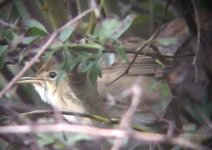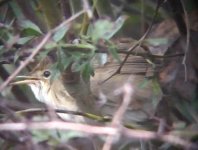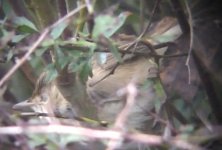I know it has been ages since this thread was last posted but I am interested in this and I don't think a conclusion weas reached on this one.
Earlier today I had been studying my bird books to try and learn differences between Marsh, Reed and Blyth's.
I am not that experienced with warblers, but studying these pictures is giving me some practice picking the key points out.
From what I read you can distinguish Blyth's from reed by the dark tip to the lower mandilble, which, unless I am mistaken is apparent here.
However the supercillium is too coloured for Blyth's. The eye ring at is not prominent at the top of the eye (probably) singling out Marsh.
Blyth's are meant to have a shorter primary projection than Marsh or reed. THe wings do look short but it is hard to see in these images.
I am left with the conclusion that this is porbably just a reed warbler with a dark bill, but it could be Blyth's, I don't know. This is ther first time I have tried to distinguish these species in a photo. Don't take my opinion because it is probably wrong and I am already going through enough trying to learn female Harriers, Petrels and distant juvenile Skuas!







